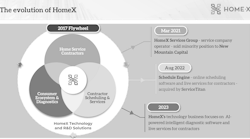I’ve seen the future of service contracting and it’s absolutely amazing. It started with a visit to UI Labs in Chicago, in itself an amazing place. UI Labs calls itself an “innovation accelerator” and a “catalyst.” It puts together various manufacturers and emerging technologies to create leading edge products and solutions. It gets a lot of its funding from the Department of Defense and DARPA, the Defense Advanced Research Projects Agency, real techie stuff.
One of the products that they showed me was called Remote AR (scopeAR.com) video augmented reality that allows, say, your service manager or top technician, to see what your field techs are trying to fix. The demo used a tablet computer. Hold it up in front whatever you’re fixing and it can superimpose repair instructions on the tablet. It works on any hardware platform, which means you could use augmented reality glasses too. The only thing holding it back is content — industry manufacturers have to enter their repair data into the Scope AR platform to make it work.
The next major development was two announcements from XOEye Technologies (xoeye.com) that it has sold hundreds of augmented reality glasses to Lee Co., Franklin, Tennessee, and Brady Services, Greensboro, North Carolina.
(See August 2016 CB, p. 36, or visit online, at bit.ly/SmartGlassesLeeCo)
The results have been stunning for Lee Co., one of the nation’s largest mechanical contractors, that’s reporting a $20 ROI for each dollar invested. Lee Co. is saving $500 a month per technician on travel and labor costs and getting an additional $2,500 per month in incremental sales per happy customer. They’re also able to hang on to older top tier techs that want to get away from the physical demands of onsite work. They can give junior technicians immediate support. The smart glasses, which capture and stream high fidelity audio and visual content, enabling first-person point-of-view, were rolled out to Brady Services field technicians as part of the company’s vision of changing from a building services company that uses technology to a technology company in the building services market.
Brady provides customers with a diverse range of HVAC and building solutions, including building automation, energy conservation, green design, and mechanical solutions.
“As part of this vision, we look for partners to help us use new technology to increase value for our customers,” said Brady President Jim Brady. “In this case, XOEye helped us figure out how to simultaneously increase value to our customers and help our technicians be more productive.”
The last technology I came across was at the Trimble Dimensions conference in Las Vegas that attracted around 4,000 Trimble customers, including those in construction. Trimble is partnering with Microsoft in “mixed reality” via Microsoft HoloLens. HoloLens will allow collaborators on a project who don’t even need to be in the same state to view and walk around and through a 3D model of a building that’s projected in front of them.
The really exciting demo for HVAC and mechanical contractors showed the BIM model projected in actual dimensions inside a building under construction. A project manager can look up into the ceiling cavity and see yet-to-be-installed ductwork and how it fits in with plumbing, sprinkler piping and electrical conduit, either installed or not. If the sprinkler piping, for example, has already been installed but it’s on the wrong level, the BIM model in the HoloLens will show where it should be and if it will clash with duct or pipe yet to be installed.
This is where technology can ameliorate the workforce crisis. We have a skilled workforce now but it’s one that either can’t or doesn’t want to climb ladders, crawl around on concrete floors, or stand on a rooftop in January. These seasoned techs can use technology to transmit their expertise to junior techs.
A happier workforce. Happier customers. More money. Go for it.









